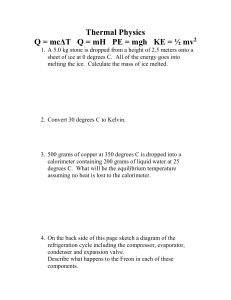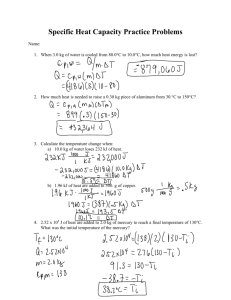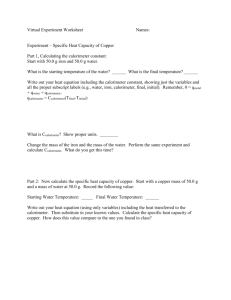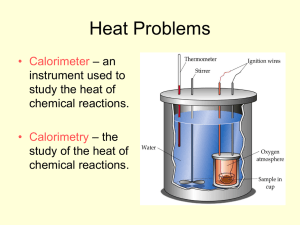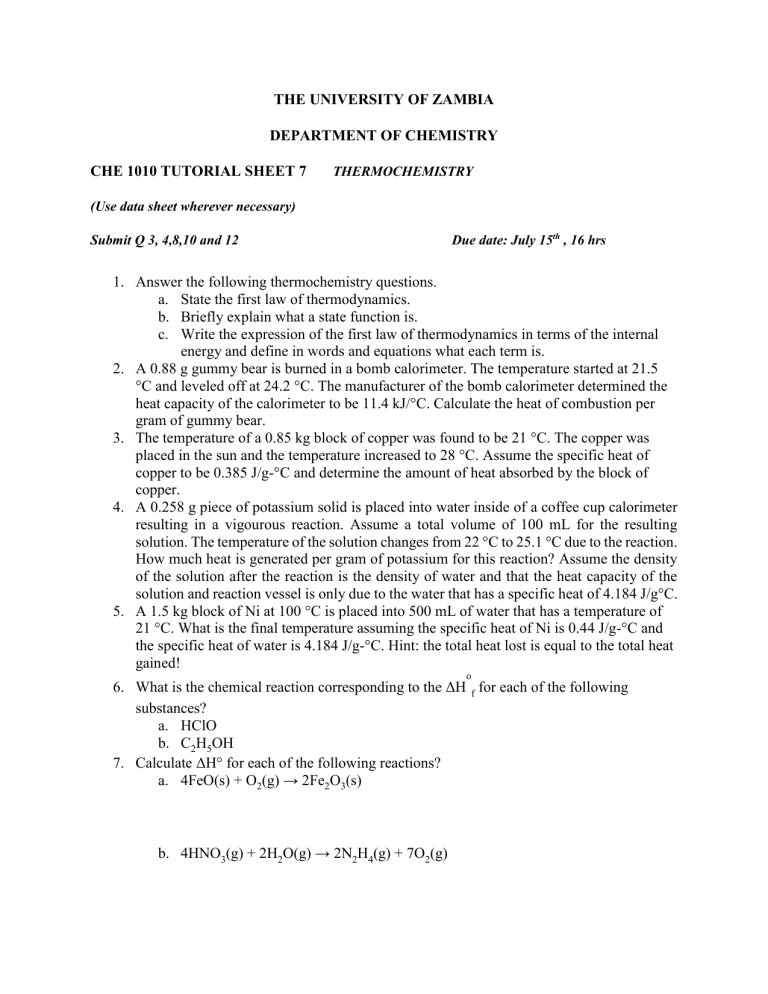
THE UNIVERSITY OF ZAMBIA DEPARTMENT OF CHEMISTRY CHE 1010 TUTORIAL SHEET 7 THERMOCHEMISTRY (Use data sheet wherever necessary) Submit Q 3, 4,8,10 and 12 Due date: July 15th , 16 hrs 1. Answer the following thermochemistry questions. a. State the first law of thermodynamics. b. Briefly explain what a state function is. c. Write the expression of the first law of thermodynamics in terms of the internal energy and define in words and equations what each term is. 2. A 0.88 g gummy bear is burned in a bomb calorimeter. The temperature started at 21.5 °C and leveled off at 24.2 °C. The manufacturer of the bomb calorimeter determined the heat capacity of the calorimeter to be 11.4 kJ/°C. Calculate the heat of combustion per gram of gummy bear. 3. The temperature of a 0.85 kg block of copper was found to be 21 °C. The copper was placed in the sun and the temperature increased to 28 °C. Assume the specific heat of copper to be 0.385 J/g-°C and determine the amount of heat absorbed by the block of copper. 4. A 0.258 g piece of potassium solid is placed into water inside of a coffee cup calorimeter resulting in a vigourous reaction. Assume a total volume of 100 mL for the resulting solution. The temperature of the solution changes from 22 °C to 25.1 °C due to the reaction. How much heat is generated per gram of potassium for this reaction? Assume the density of the solution after the reaction is the density of water and that the heat capacity of the solution and reaction vessel is only due to the water that has a specific heat of 4.184 J/g°C. 5. A 1.5 kg block of Ni at 100 °C is placed into 500 mL of water that has a temperature of 21 °C. What is the final temperature assuming the specific heat of Ni is 0.44 J/g-°C and the specific heat of water is 4.184 J/g-°C. Hint: the total heat lost is equal to the total heat gained! o 6. What is the chemical reaction corresponding to the ΔH f for each of the following substances? a. HClO b. C2H5OH 7. Calculate ΔH° for each of the following reactions? a. 4FeO(s) + O2(g) → 2Fe2O3(s) b. 4HNO3(g) + 2H2O(g) → 2N2H4(g) + 7O2(g) 8. Calculate ΔH for O3(g) + 2NO2(g) → N2O5(g) + O2(g) Given the following equations: O3(g) + NO2(g) → NO3(g) + O2(g) N2O5(g) → NO3(g) + NO2(g) ΔH = 10.1 kJ ΔH = 48.3 kJ 9. Calculate ΔH for 4K2O(s) + 3O2(g) → 3K2O2(s) + 2KO2(s) Given the following equations: K2O(s) + ½O2(g) → K2O2(s) ΔH = -132.6 kJ 4KO2(s) → 2K2O(s) + 3O2(g) ΔH = 411.6 kJ 2KO2(s) → K2O2(s) + O2(g) ΔH = 73.2 kJ 10. When one mole of solid naphthalene, C10H8, is completely burned 4981 kJ of heat is o given off. Assume that H2O(g) is produced and that for CO2, ΔH f = -393.5 kJ/mole. o What is ΔH f for naphthalene? 11. A common gasoline additive is octane, C8H18. When octane is burned it produces heat according to the following equation. 4 2C8H18(l) + 25O2(g) → 18H2O(g) + 16CO2(g) ΔH = 1.02 x 10 kJ a. How much heat is produced per mole of octane? b. How much heat is produced when 10 g of octane is burned? 12. What is the bond energy of an O-H bond in H2O(g)?


